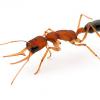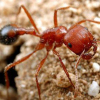Some sort of Formica, I know.
Maybe Tetramorium? It's about 3 mm long, orangeish legs, black body, pretty big head compared to its gaster, propodeal spine/s. Myrmicine.
Maybe some kind of Lasius? Bright orange all around (gaster almost transluscent). Found nesting under moss. Around 2 mm long.
If you could ID these down the species, that'd be great.
Edited by TheMicroPlanet, April 6 2020 - 9:30 AM.




















